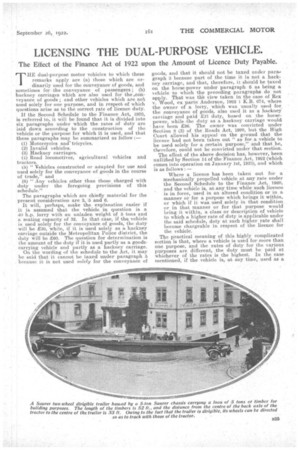LICENSING THE DUAL-PURPOSE VEHICLE.
Page 9

Page 10

If you've noticed an error in this article please click here to report it so we can fix it.
The Effect of the Finance Act of 1922 upon the Amount of Licence Duty Payable.
THE dual-purpose motor vehicles to which these remarks apply are (a) those which are ordinarily used for the conveyance of goods, and sometimes for . the conveyance of passengers ; (b) hackney carriages which are also used for the ,conveyance of goods ; and other vehicles which are not used solely for one purpose, and in respect of which questions arise as to the correct rate of licence duty.
If the Second. Schedule to the Finance Act, 1920, is referred to, it will be found that it is divided into six paragraphs under which the rates of duty are laid down according to the construction of the vehicle or the purpose for which it is used, and that these paragraphs may be summarized as follow:—
(1) Motorcycles ands-tricycles.
(2) Invalid vehicles.
(3) Hackney carriages.
(4) Road locomotives, agricultural vehicles and tractors.
k5) " Vehicles constructed or adapted for use and used solely for the conveyance of goods in the course of trade," and (6) "Any vehicles other than those charged with duty under the foregoing provisions of this schedule."
The paragraphs which are chiefly material for the present consideration are 3, 5 and 6.
It will, perhaps, 'make the explanation easier if it is assumed that the vehicle in question is a 44) h.p. lorry with an unladen weight of 5 tons and a seating capacity of 32. In that case, if thq vehicle is used solely for the conveyance of goods, the duty will be £30, while, if it is used solely as a hackney carriage outside the Metropolitan Police district, the duty will be £60. The question for determination is the amount of the duty if it is used partly as a goodscarrying vehicle and partly as a hackney carriage.
On the wording of the schedule to the Act, it may be said that it cannot be taxed under paragraph 5 because it is not used solely for the conveyance of
goods, and that it should not be taxed under para. graph 3 because part of the time it is not a hackney carriage, and that, therefore, it should be taxed on the horse-power under paragraph 6 as being a vehicle to which the preceding paragraphs do not apply. That was the view taken in the case of Rex v. Wood, ex parte Anderson, 1922 t K.B. 674, where the owner of a lorry, which was usually used for the conveyance of goods, also used it as a hackney carriage and -paid 1121 duty, based on the horsepower, while .the duty as a hackney carriage would have been £36. The owner was convicted under Section 8 (3) of the Roads Act, 1920, but the High Court allowed his appeal on the ground that the licence had not been taken out " as for a vehicle to be used solely for a certain purpose," and that he, therefore, could not be convicted under that section.
The effect of the above decision has, however, been nullified by Section 14 of the Finance Act, 1922 (which comes into operation on January 1st, 1923), and which is as follows:—
Where a licence has been .takeri out for a mechanically propelled vehicle at any rate under the Second Schedule to the Finance Act, 1920, and the vehicle is, at any time while such licence is in force, -used in an altered condition or in a manner or for a purpose which brings it within, or which if it was,used solely. in that condition or in that manner or for that purpose would bring it within, a class or description of vehicle to which a higher rate of duty is applicable under the said schedule, duty at, such higher rate shall become chargeable in respect of the licence for the vehicle'.
The practical meaning of this highly complicated section is that, where a vehicle is used for more than one purpose, and the rates of duty for the various purposes are different, the duty must be paid at whichever of the rates is the highest.. In the case mentioned, if the vehicle is, at any time, used as a
hackney carriage, the duty payable will be £60, although the payment of that duty will enable the vehicle to be used for any other purpose, e.g., the conveyance of goods, because the duty under paragraph 5 would be .231).
In the same way, if the vehicle were licensed under paragraph 6 on the horse-power basis, and £40 duty paid, the vehicle could be used fat conveying goods, or for conveying passengers, provided they were not
carried for hire. For instance, it could be used for conveying employees to a football match, which could not be done if only the £30 duty had been paid. The only cases where passengers may be carried, if the duty has been paid under paragraph 5, are where they are employees of the owner and are being carried in the course of their employment, or where no charge is made and the horse-power of the vehicle does not exceed 30.




























